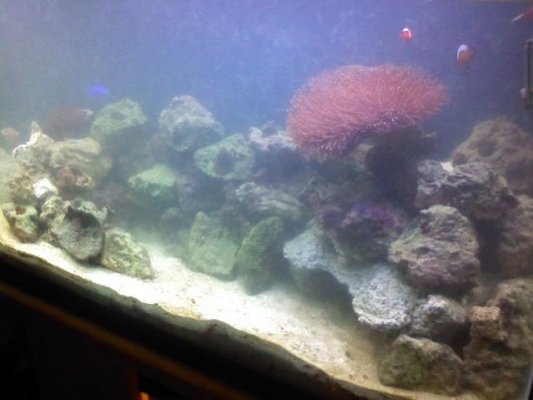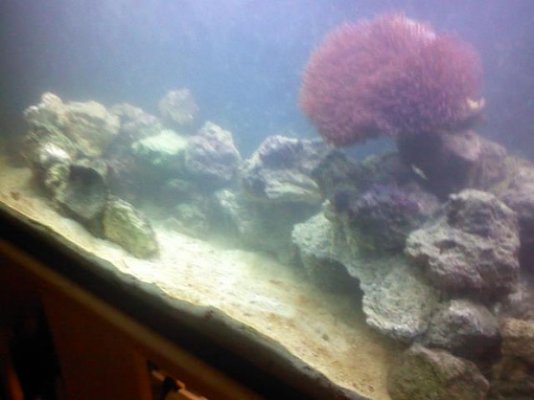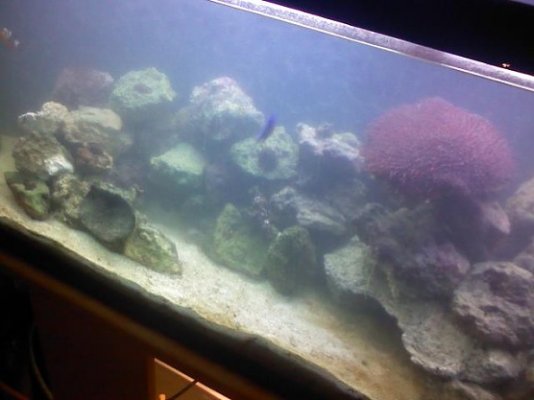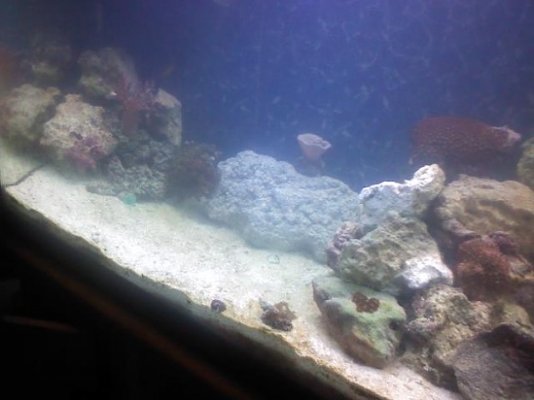I didn't say the DIY rocks are bad i was just questioning the metal content of the cement which can be potentially harmful and was curious as to why it works, all of my reading and research indicate that it's a bad thing.Hi, I saw this post about a 1/2 hour ago and wanted to do somemore homework on it before I answered it.
Portland Cement is reef safe when it is allowed to cure out. This is not to say that it would leach out some materials that some would consider unsafe. If you remember a few weeks ago there was a discussion about copper in "Spectrum marine formula" fish food.
It all comes down to how much is considered safe. Water is safe, yet people do drown in it. IMO, portland cement is reef safe when cured. So by the time the rocks PH is down to a safe level the cement has long been cured.
Is Portland cement safe in a Reef Aquarium?
1) http://www.reefs.org/library/talklog/t_miller_052498.html
2) http://www.garf.org/news9p2.shtml
3)http://www.geocities.com/CapeCanaveral/Hangar/6279/RaiseCementRock.html
4) http://www.ultimatereef.net/forums/showthread.php?t=304845
5) http://www.fishforums.net/lofiversion/index.php?t286955.html
6)
You are using an out of date browser. It may not display this or other websites correctly.
You should upgrade or use an alternative browser.
You should upgrade or use an alternative browser.
DIY Live Rock
- Thread starter darknessheir
- Start date
The friendliest place on the web for anyone with an interest in aquariums or fish keeping!
If you have answers, please help by responding to the unanswered posts.
If you have answers, please help by responding to the unanswered posts.
thincat
Aquarium Advice Addict
- Joined
- Nov 7, 2008
- Messages
- 5,330
What's a bad thing? The metals (in unmeasurable amounts) or the cement as a whole. I looked up lots of leads on DIY rock and none said any ill affects of it. The only warnings are about curing and that was the high PH factor.
This is my last post on this subject.......................
This is my last post on this subject.......................
I have no idea why you're getting so defensive, there is no need. The fact of the matter the stuff contains high contents of metal and some of which will rust end of story. If you don't believe take some of your rock especially wet take a DMM and put it on the highest scale and put the probes at the opposite ends of the rock you will read continuity. If you can read continuity with a regular old multimeter it is definitely measurable. Get over yourself pal, besides it was just an inquiry and you're going off the deep end.
want2findnemo
Aquarium Advice Freak
- Joined
- May 11, 2008
- Messages
- 205
Hi All,
been awhile since I posted.
I have DIY LR
http://www.aquariumadvice.com/forums/f20/diy-rock-104715.html
in my tank (which I started about a year ago with the help of the folks here) and I haven't had any issues with livestock (except for a very long power outage, that outlasted my UPSs)
http://www.aquariumadvice.com/forums/f14/want2findnemos-75g-tank-build-updated-118314.html
Can you tell which ones are DIY and which ones are Tonga/fiji LR?
I think the only differences is that DIY will never provide the same beneficial biological filtration that real LR will.
Ive been to people to peoples house who have a generous amount of the rock structure within their display tank as DIY LR. They have had their tank up for mroe than 5 years. (they have to supplement with LR in the sump though)
been awhile since I posted.
I have DIY LR
http://www.aquariumadvice.com/forums/f20/diy-rock-104715.html
in my tank (which I started about a year ago with the help of the folks here) and I haven't had any issues with livestock (except for a very long power outage, that outlasted my UPSs)
http://www.aquariumadvice.com/forums/f14/want2findnemos-75g-tank-build-updated-118314.html
Can you tell which ones are DIY and which ones are Tonga/fiji LR?
I think the only differences is that DIY will never provide the same beneficial biological filtration that real LR will.
Ive been to people to peoples house who have a generous amount of the rock structure within their display tank as DIY LR. They have had their tank up for mroe than 5 years. (they have to supplement with LR in the sump though)
thincat
Aquarium Advice Addict
- Joined
- Nov 7, 2008
- Messages
- 5,330
This is true, diversity only comes by introducing many different types of live rock into your tank. Every new beach I go to I bring home a cup of sand and add that to my tank for diversity. I know the bit about adding the potential of contaminates to the tank, but just use common sense and you should be Okay.
want2findnemo
Aquarium Advice Freak
- Joined
- May 11, 2008
- Messages
- 205
Its fun because you can create your own shapes and use your imagination to create aquascapes.
I've actually gone beyond that and have used foam, pvc etc. to create a bridge, wall and island
But if you think DIY rock will supplement LR and save you tons of dollars, you might want to think twice.
Many of the DIY LR people have sumps full of LR rock and rubble.
I am of course talking from my experience and am no expert but everyone has their own opinion and if you put in the time to research and you do it right (patiently) it should work out for you like it has for all the others...
HTH
I've actually gone beyond that and have used foam, pvc etc. to create a bridge, wall and island
But if you think DIY rock will supplement LR and save you tons of dollars, you might want to think twice.
Many of the DIY LR people have sumps full of LR rock and rubble.
I am of course talking from my experience and am no expert but everyone has their own opinion and if you put in the time to research and you do it right (patiently) it should work out for you like it has for all the others...
HTH
thincat
Aquarium Advice Addict
- Joined
- Nov 7, 2008
- Messages
- 5,330
You are correct, sooner or later you will have to add diversity to the mix and the best way is some lr. But as I said above, get some from one place and some other. The more different spots the more the diversity. And as you get better pieces of rock albeit DIY or LR the surplus goes into your sump. 
divedeep1689
Aquarium Advice Addict
a piece of diy rock in tank 3 pieces in it acrually you can only see 2 tho in two of the pics you can see a small cave on the bottom one pic you can see a small regular long piece ( NOTE PUT THE PICS TOGETHER IN YOUR MIND TO SEE THE WHOLE LENGTH OF TANK LOL!! 
Attachments
divedeep1689
Aquarium Advice Addict
Wont let me post the small piece i will retake later its cloudy now
divedeep1689
Aquarium Advice Addict
divedeep1689
Aquarium Advice Addict
Now this is no were near finished i still have alot of rocks to put in  including a arch which may not go in
including a arch which may not go in
roka64
Aquarium Advice Addict
- Joined
- Mar 21, 2006
- Messages
- 13,858
Looking great, it looks to have great surface area!
divedeep1689
Aquarium Advice Addict
Wat ya mean by surface area rocka sorry i still a 

roka64
Aquarium Advice Addict
- Joined
- Mar 21, 2006
- Messages
- 13,858
More surface area means more area for your beneficial bacteria to live!
divedeep1689
Aquarium Advice Addict
Oh cool 
thincat
Aquarium Advice Addict
- Joined
- Nov 7, 2008
- Messages
- 5,330
Yes, nice rock looks very porous with lots of nooks and cranny's for the bacteria to make a home in.
divedeep1689
Aquarium Advice Addict
thanks
divedeep1689
Aquarium Advice Addict
checked ph in display tank and rock tank today still around 8.0 to 8.2 not getting any higher so i think i have got my diy rock ready for the tank  i already have had the three peices in the tank and the ph is looking good so i am going to add another peice today
i already have had the three peices in the tank and the ph is looking good so i am going to add another peice today 
thincat
Aquarium Advice Addict
- Joined
- Nov 7, 2008
- Messages
- 5,330
Great! It's......................


Similar threads
- Replies
- 2
- Views
- 201
- Replies
- 5
- Views
- 681
- Replies
- 2
- Views
- 749




